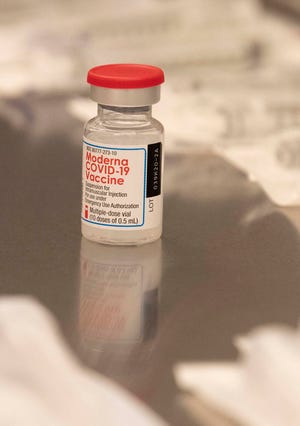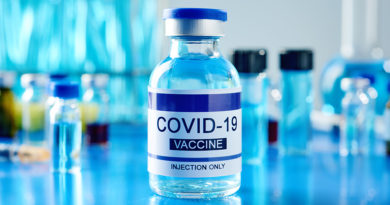Will you get a COVID-19 vaccine? Many say no despite health officials’ assurances
Michelle Lang Schock survived a mastectomy and six rounds of chemotherapy seven years ago while she was pregnant, followed by radiation and a second mastectomy after she gave birth to a healthy daughter.
Now Schock is cancer free, but the drugs she takes to prevent the disease from coming back leave her immuno-compromised, one of the underlying health conditions that makes people particularly vulnerable to severe illness if they are infected with COVID-19.
More:Here are the pharmacies offering a COVID-19 vaccine in Summit County
On Feb. 1, Schock and other Ohio school employees will be eligible for the COVID-19 vaccine.

But Schock — who works at her daughter’s Massillon elementary school monitoring lunch and recess — isn’t going to take it even though health officials say it’s effective at preventing COVID-19 in about 95% of people.
“I’m not freaked out about getting COVID. I’m not afraid of it,” Schock said. “And I’m not getting the vaccine.”
Schock is among millions of Americans who don’t trust the vaccines that public health officials say are essential to break free of the pandemic and all the efforts to restrict the spread of COVID-19.
40% of Americans surveyed won’t take the COVID-19 vaccine
In December, the Pew Research Center said that 40% of Americans surveyed said they would definitely not or probably not take the vaccine.
The number of those refusing the vaccine was even higher among staff at Ohio nursing homes, where about 60% of workers declined the vaccine during its initial rollout in recent weeks.
That’s bad news for anyone hoping to avoid COVID-19 or to return to a pre-pandemic life of carefree get-togethers, in-person work or going out to eat.

Dr. Anthony Fauci, head of the National Institute for Allergy and Infectious disease, has estimated that between 70% and 85% of all Americans must be vaccinated to reach herd immunity, the point at which COVID-19 will have a difficult time spreading.
“If everything goes right, this will occur some time in the fall of 2021,” Fauci said.
Disputing vaccine myths: Ohio officials look to relieve doubts
To get there in Ohio, state officials, unions who represent frontline workers, physicians and public health officials are working to educate people about the vaccines and to knock down myths and conspiracy theories that continue to spread on social media.

Dr. Amy Raubenolt, an emergency medicine physician at Cleveland Clinic Akron General, said she’s most often asked if the vaccine is safe because it seemed to be developed so quickly.
“I think it relieves a lot of people’s fear when they learn the (vaccine) tech is not as new as it seems,” Raubenolt said. “They actually started on the technology in 2003 with the first SARS outbreak.”
SARS, or severe acute respiratory syndrome, is a viral respiratory illness caused by a similar coronavirus to COVID-19.

Compared to COVID-19 — which had killed about 2 million around the world and nearly 10,000 Ohioans by the second week of January — SARS had a small impact. The World Health Organization estimates that about 8,100 people, including eight people in the U.S., became ill with SARS and 774 died.
But SARS and similar viruses since have prompted more than a decade of research into vaccines.
When COVID-19 was discovered, scientists were able to develop a vaccine so quickly last year because of that research and the extraordinary funding that went into trials to test the vaccines’ effectiveness and safety on thousands of people.
“I don’t think people understand the amount of money and resources that went into this,” Raubenolt said.
The funding for measles, mumps or rubella vaccines is dwarfed compared to COVID-19, even if adjusted for inflation.
“There’s no way anything even came close,” Raubenolt said.
Understanding the vaccine’s lengthy research history often soothes anxiety about safety, Raubenolt said.
But so will time and experience, she said. Most Ohioans likely won’t be able to receive the vaccine until late summer, and that’s if manufacturing and distribution goes as planned.
By then, many Ohioans will know someone who already received a vaccine — health care and school workers, older people or another groups Ohio selected to get vaccines first.
“I think that will make a lot of fears go away,” said Raubenolt, who late last year prepped Akron firefighters with information when they became eligible for the COVID-19 vaccine.
By the end of the first week of January, about 63% of Akron’s uniformed personnel, or about 219 fire department employees, had been vaccinated with the first dose, the department said.
Kevin Gostkowski, president of Akron Fire Fighters Local 330, was among them. He was vaccinated the morning after Christmas. His wife, a nurse, was vaccinated a few days later.
“Anything that will help us get back to some normalcy in this world, I’m all for it,” he said.
Gostkowski said he knows how COVID-19 has impacted his colleagues who have been infected and how prevention efforts have impacted families.
“The hardest part is our girls play with the two girls down the street,” he said. “That’s over. There’s no playing dolls in the basement any more.”
Gostkowski said he had a little pain in his arm near the vaccination site, but nothing more severe arm pain after flu shot.
No one Gostkowski knows had a severe reaction.
“We’re encouraging as many of our members to get it as can,” Gostkowski said. “But everyone should make their own decision. Do your own research and find out for yourself. It’s actually very safe.”
Ohioans express doubt: ‘Would I get a vaccine? No’
Michelle Lang Schock is unconvinced.
The former Wadsworth resident believes the danger of COVID-19 has been overblown and that no one yet knows enough about the vaccines.
“I think they’re using us as guinea pigs,” she said.

She knows COVID-19 can be serious. A friend’s aunt in Cincinnati died, but Schock points out the woman had an underlying condition. And a colleague who became infected was off work for months, but Schock points out that she is older, probably in her 60s.
When Schock’s middle child, Bella Wertman, who is 14, tested positive for COVID-19 in early December, the teen quarantined in her bedroom.
Schock’s husband, who has diabetes, and her son Max, who has asthma — both underlying conditions that put people at higher risk for severe illness if they’re infected with COVID-19 — stayed away from Bella.
But Schock, despite being immuno-compromised, brought food into her daughter’s room and visited her to break Bella’s loneliness.
Bella lost her senses of taste and smell, but never got anything more than a sore throat and stuffy nose, Schock said.
No one else in the family became infected and by New Year’s, the Schocks hosted a party for two other families at their home.
“If you’re going to get it, you’re going to get it and I think everyone’s going to get (COVID-19) at some point,” Schock said.
So Schock washes her hands, cleans her house and uses hand sanitizer. And she’ll wear a mask if someone asks, or when it’s required, like at her job at school.
But she has no plans to get vaccinated.
“If my husband or my son, Max, got it and they had to be in the hospital, would I wear a mask more? Yes,” Schock said. “But would I get a vaccine? No.”
*** This article has been archived for your research. The original version from Akron Beacon Journal can be found here ***


